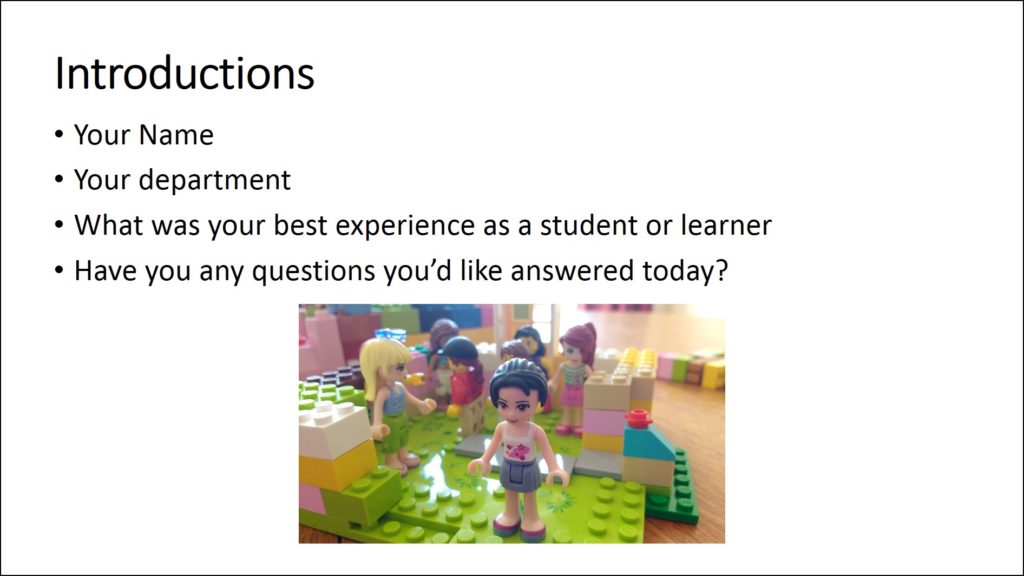One of the four principles and values that inform the CMALT scheme (and to which portfolios are assessed) is:
An empathy with and willingness to learn from colleagues from different backgrounds and specialist options.
I demonstrate this to candidates with examples from submissions where it has not been met e.g. “shifting tutor perception” or “dealing with the unhelpful IT staff” are not respectful of the the perspectives of other professional colleagues.
At the CMALT meetings I aim to get the group to form a supportive respectful network. I hope that working towards CMALT together will build empathy by humanising people and going beyond stereotyped view of job roles or institutional silos what “a librarian” or “an academic” is like and what they do. It gives an opportunity to see that learning and teaching practice is not confined to academic lecturing roles. It offers opportunities to learn non-mainstream ideas of teaching and learning from others for e.g. those specialising in distance education or working in different disciplines.
To create a respectful open forum I start every meeting with introductions, including a question to assess their current understanding and expectations so I can address these. I model the kind of interactions I want to encourage – thanking people for their contributions and encourage people to build on each and make connections between what others say. I set the room so we all sit round a table and start with introductions because I want everyone to be equal within this group.

I send anonymous evaluations after every session and so participants have a way to feed back safely if they didn’t feel they could say it at the time.
The CMALT participants are a diverse cross section of people from across the University: professional services staff, administrators, librarians and academic staff who work at different levels in the institutional hierarchy. There is a range of ages and varying levels of experience. In writing this blog and thinking about the Equality Act 2010 and the 9 protected characteristics :
- age
- disability
- gender reassignment
- marriage or civil partnership (in employment only)
- pregnancy and maternity
- race
- religion or belief
- sex
- sexual orientation
My small group (33) is a diverse microcosm of the university, I am mindful that people are not required to disclose characteristics so it is my job to be aware. Also, recent conversations with a colleague reminded me that the protected characteristics do not include other types of diversity such as class and socio-economic status.
One member of the group has a declared disability (ADHD) and has requested reasonable adjustments. We worked together to decide what adjustments would be benefit them. Group meetings were challenging – so we have shorter more focused 1-to-1 meetings instead. They found the CMALT guidelines overwhelming and requested something more ‘step-by-step’ so I wrote a Week By Week Plan, which I have since shared with the rest of the group.
The group includes members from different cultures and countries and several for whom English is not their first language. I try to be mindful of cultural context e.g. we define all terms as we meet them to make sure everyone has the same interpretation. There are people of both male and female genders and one person who prefers not be be defined as either – so I an careful in use of personal pronouns and in taking cues from how others describe themselves. (V1)
ELDeR workshops also have a mixed group of professionals in attendance and I approach these with the same care and respect. Institutional hierarchy can be relevant within the sessions – there can be obvious power dynamics. It’s differs as I only work with ELDeR groups for a two days while I have longer to form relationships with the CMALT applicants.
Earlier this year I attended the “Innovations in Pedagogy Summit” at the University of Virginia as part of an ERASMUS training visit (I’ve blogged about this here). The theme was “Creating Inclusive Classrooms: Shifting from Thinking to Doing” and the keynote presentation for this was a theatrical performance given by the the University of Michigan’s CRLT Players.
We watched a group of students performing scenarios around experiences of inclusion. This was framed by an excellent facilitator who set groudrules for our participation and got us to work through a series of reflective exercises around each piece. This was really powerful, the students were excellent performers and there was something much more real about watching the scenarios acted out by students who could ‘be’ the characters they are playing.
I felt myself reacting personally to watching the young woman’s contribution being casually belittled by a well meaning professor. ‘Oh’ I thought ‘That’s how it happens’ – I recognise that.
In another sketch – a young man was asked by his German language teacher to say a sentence about who he loved – when he referred to the person loved as ‘he’ – the teacher corrected the gender to ‘she’. But the student hadn’t made a mistake.
I vividly remember the sketch in which an Asian man expresses his inner dialogue when confronted with engaging with the aggressive discussion style of a US tutorial.
It was very moving and thought provoking watching a young Black man reacting to the barrage of ‘microagressions’ – ranging from misplaced humour to outright abuse he received over a period of time.
Watching people perform was more engaging than hearing the scenarios read out or watching videos. Having the student performers in the room was an important part of this experience.
Being an outsider in that event – made it a great deal easier – as it uncomfortable. It must have been very intense for the UVa staff. I’ve not attended anything at UoE that addressed homophobia, sexism or racism so directly. Some comments were thoughtless not malicious but very hurtful to the recipients. In response to this I am reviewing my practice and being additional mindful of my own behaviour.